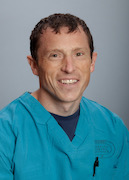Board of Trustees Trustee

My wife, Sarah Menashe, and I live in Bellevue, Washington, a suburb of Seattle, where we are both physicians. I am a cardiac anesthesiologist at Overlake Hospital and, as luck would have it, Sarah is a pediatric radiologist at Seattle Children’s Hospital. We have two children; our daughter June, who is 9, and our son, Harvey, who is 6. It is our son who has a Chiari 1 malformation.
A few years ago, when he was 2 or 3, Harvey began complaining of head and neck pain after coughing. At first, we didn’t think much of it; frequently, these symptoms were associated with an acute upper respiratory illness and fever, so we attributed them to muscle aches and pains. But, gradually, we realized that even when he wasn’t acutely ill, whenever he would cough, he was in pain. Although I tried to minimize the significance of the headaches, Sarah insisted that something more serious was going on and that Harvey needed medical attention.
With the support of our pediatrician, Harvey got an MRI and our fears were confirmed: he had a significant Chiari malformation. Sarah had seen these types of images so many times as a pediatric radiologist, but neither one of us thought they would ever belong to our son. We were devastated, scared, and confused. By virtue of working at Seattle Children’s Hospital, Sarah knew Dr. Rich Ellenbogen and was able to quickly arrange a meeting. Harvey had decompression surgery 4 weeks later.
Although I’ve had years of medical training, I’m embarrassed to admit that my knowledge of Chiari malformations and syringomyelia was quite limited. Nevertheless, during that period, and for months after, Sarah and I just put our heads down to “get through it.” We both took off our medical hats and coped with his diagnosis, in part, by declining to investigate the disease. Furthermore, we didn’t want to talk to other parents or patients. We didn’t want to hear anyone else’s story, good or bad: we just wanted the whole thing to be over.
Months after Harvey’s surgery, Dr. Ellenbogen invited Sarah and me to a roundtable discussion on Chiari malformations that was hosted by the Bobby Jones CSF. At the talk, Sarah met Dorothy Poppe and spoke with parents of other children who were battling this disease. That event was a tipping point for Sarah and me; we finally came to terms with the fact that our son’s Chiari is not a diagnosis with a surgery and certificate of completion. While we are fortunate that Harvey has not experienced some of the associated comorbidities often associated with Chiari, we know he’s at risk for many of them. This diagnosis will be something he deals with for his entire life.
Our hope is to engage on both a national and local level to be involved in, and support, Chiari research and outreach. Here in our hometown, we are in the process of setting up both an endowment and a working research fund at Seattle Children’s Hospital to support our local physicians and scientists dedicated to Chiari research. However, we believe that being involved at a national level will allow us to more fully engage in fundraising and multi-institutional investigations, both key components in furthering awareness and understanding of this disease.